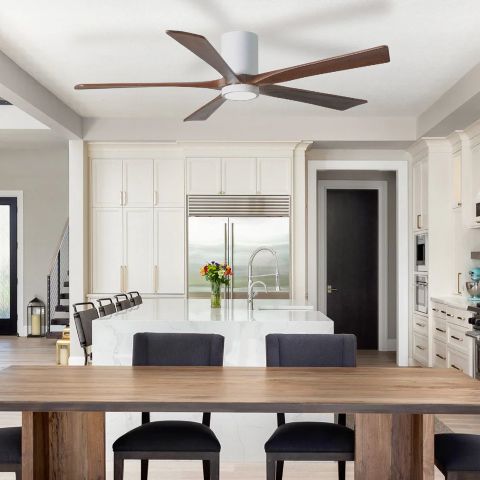Are you tired of battling the sweltering summer heat while watching your energy bills skyrocket from constant AC use? You’re certainly not alone in this struggle. Many homeowners face the same dilemma: maintaining comfort without draining their finances. However, there’s a straightforward solution right above you—ceiling fans! But it’s not just a choice between one or the other; this guide will delve into the complementary relationship between ceiling fans and air conditioning, revealing how these fixtures can elevate your home’s efficiency and comfort levels.
Do Ceiling Fans Help Air Conditioning?
Yes! In fact, combining ceiling fans with your air conditioning isn’t just a good idea; it’s a game-changer. Picture this: a cooler home, lower energy bills, and a cozier atmosphere all year round. That’s the magic of teamwork. When these two systems work together, they create something greater than the sum of their parts. So, let’s learn more about how this simple integration can make a big difference in your comfort and your wallet.
How Ceiling Fans Boost Air Conditioner Efficiency
Ceiling fans aren’t just about adding a breeze to your room; they’re a strategic ally in maximizing your air conditioner’s efficiency. Here’s how they help circulate air conditioning:
- Fan blade direction and air movement: During the scorching summer months, it’s crucial to ensure your ceiling fan is rotating in the correct direction: counterclockwise. This setting creates a downward airflow, enhancing your air conditioner’s cooling effect. As the fan blades spin, they create a wind-chill effect (more on that in a bit!), making you feel cooler even at higher room temperatures. By complementing your air conditioner in this way, you can achieve the same level of comfort while potentially reducing your energy usage.
- Improving air distribution: Have you ever noticed that certain areas of your home feel cooler than others when the air conditioner is running? That’s where ceiling fans come in handy. By circulating the air throughout the room, ceiling fans help to break up pockets of stagnant air and distribute the cool air more evenly. This prevents hot spots from forming and ensures that every corner of the room receives a refreshing breeze. With better air circulation, your air conditioner doesn’t have to work as hard to maintain a comfortable temperature, ultimately leading to energy savings.
- Reducing energy and operational costs: Here’s where things get exciting. Using ceiling fans allows you to dial up your thermostat by as much as 4°F without sacrificing comfort. That may not sound like much, but every degree counts when saving energy and money. Studies have shown that raising the thermostat by just 1°F can reduce cooling costs by 3-5%. With ceiling fans helping to maintain a comfortable environment, you can take advantage of these higher thermostat settings, leading to significant energy and cost savings over time.
The Wind Chill Effect and Its Impact on Perceived Temperature
Ever experienced that instant relief when a breeze hits you on a hot day? That’s the wind chill effect in action. Ceiling fans work similarly, creating a gentle breeze that accelerates the evaporation of perspiration on your skin. As sweat evaporates, it releases heat from your body, making you feel cooler. So, even if the actual room temperature remains unchanged, the perceived temperature can be significantly lower with the help of a ceiling fan.
Now, let’s talk about thermostat settings. With a ceiling fan in play, you can afford to dial up the thermostat by a few degrees without sacrificing comfort. The U.S. Department of Energy suggests raising the set temperature by around 4°F when using a ceiling fan. Thanks to the cooling sensation created by the fan’s breeze, you’ll still feel just as comfortable at the higher thermostat setting, if not more so. This simple adjustment can yield substantial energy savings without compromising indoor comfort.
Seasonal Versatility of Ceiling Fans
As the seasons shift and temperatures drop, your ceiling fan can still play a vital role in maintaining comfort and efficiency – but with a twist, quite literally. In winter, it’s time to switch things up and set your fan to rotate clockwise. This adjustment might seem counterintuitive, but it’s the key to optimizing your heating system’s performance. By rotating clockwise, the fan gently pulls cool air up and pushes warm air down from the ceiling, effectively redistributing the heat throughout the room. This simple change can make your heating system more efficient, helping you stay cozy while reducing energy costs.
Ceiling fans aren’t just for extreme temperatures but are also incredibly useful during transitional seasons like spring and autumn. During these milder months, you may not need to rely heavily on your heating or cooling systems. Instead, you can harness the power of ceiling fans to maintain a comfortable indoor environment while minimizing energy consumption.
By circulating the air and creating a gentle breeze, fans help prevent stuffiness and keep temperatures in check without requiring the full force of your HVAC system. This saves energy and extends the lifespan of your heating and cooling equipment, reducing the need for repairs and replacements in the long run. So, your ceiling fan keeps you comfortable all year round, whether in sweltering summer heat or chilly winter nights!
Optimal Ceiling Fan Installation and Usage
When choosing the perfect ceiling fan for your space, size matters. Consider the room’s dimensions, the ceiling’s height, and your usage patterns. For larger rooms, opt for fans with larger blade spans to ensure adequate air movement. Conversely, smaller rooms call for flush mount fans with more compact designs. Additionally, consider the style and functionality you desire – whether a traditional, ornate fan for a formal living room or a sleek, modern design for a contemporary space. Selecting the right size and type of ceiling fan will ensure optimal airflow and comfort throughout the room.
Once you’ve chosen the ideal ceiling fan, proper installation is crucial for its effectiveness and safety. While professional installation is always recommended, DIY enthusiasts can tackle the job with the right guidance. Begin by carefully following the manufacturer’s instructions and paying close attention to safety precautions and electrical wiring guidelines.
Always use the appropriate tools and ensure the fan is securely mounted to the ceiling to prevent wobbling or shaking during operation. Additionally, if necessary, take the time to balance the fan blades using a balancing kit—this helps to minimize noise and vibration. With a properly installed and balanced ceiling fan, you can enjoy efficient airflow and enhanced comfort throughout your home.
Making the Decision: What’s Best for Your Home?
Let’s revisit the key benefits of integrating ceiling fans with your air conditioning system.
- First and foremost, this dynamic duo promises enhanced comfort by ensuring optimal airflow and temperature distribution throughout your home.
- Ceiling fans and air conditioners can work together to help you stay cool and comfortable while potentially reducing your energy usage and utility bills.
- Additionally, the gentle breeze generated by ceiling fans can alleviate strain on your HVAC system, prolonging its lifespan and reducing the likelihood of costly repairs or replacements.
It’s a win-win-win situation for your comfort, wallet, and home’s longevity.
Now that you’re armed with this valuable information, it’s time to assess your home’s cooling needs and existing systems. Walk through each room, considering room size, ceiling height, and current airflow patterns. Evaluate the performance of your air conditioning system and identify any areas where additional comfort or efficiency improvements may be needed.
If you’re considering installing new ceiling fans or updating existing ones, take measurements and research options that best suit your space and preferences. By optimizing your home’s cooling setup, you can create a more comfortable, energy-efficient living environment for years to come.






















